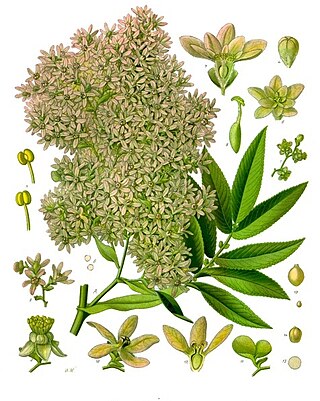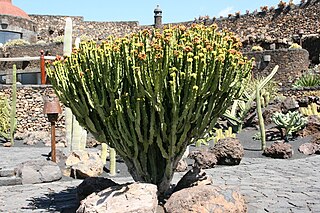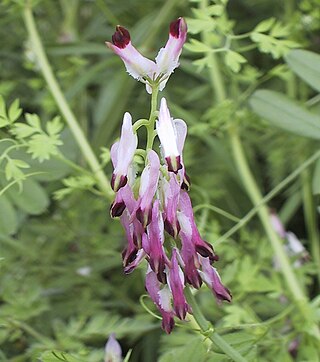
Fumaria is a genus of about 60 species of annual flowering plants in the family Papaveraceae. The genus is native to Europe, Africa and Asia, most diverse in the Mediterranean region, and introduced to North, South America and Australia. Fumaria species are sometimes used in herbal medicine. Fumaria indica contains the alkaloids fuyuziphine and alpha-hydrastine. Fumaria indica may have anti-inflammatory and analgesic potential.

Guizotia abyssinica is an erect, stout, branched annual herb, grown for its edible oil and seed. Its cultivation originated in the Eritrean and Ethiopian highlands, and has spread to other parts of Ethiopia. Common names include noog/nug ; niger, nyger, or nyjer seed ; ramtil or ramtilla; inga seed; and blackseed.

Hagenia is a monotypic genus of flowering plant with the sole species Hagenia abyssinica, native to the high-elevation Afromontane regions of central and eastern Africa. It also has a disjunct distribution in the high mountains of East Africa from Sudan and Ethiopia in the north, through Kenya, Uganda, Rwanda, Burundi, Democratic Republic of Congo, and Tanzania, to Malawi and Zambia in the south. A member of the rose family, its closest relative is the Afromontane genus Leucosidea.

Fumaria officinalis, the common fumitory, drug fumitory or earth smoke, is a herbaceous annual flowering plant in the poppy family Papaveraceae. It is the most common species of the genus Fumaria in Western and Central Europe.

Fumaria muralis, known as common ramping-fumitory or wall fumitory, is a flowering herbaceous plant in the poppy family (Papaveraceae) native to western Europe and northwestern Africa.

Oxytenanthera is a genus of African bamboo. Bamboos are members of the grass family Poaceae.

Fumaria capreolata, the white ramping fumitory or climbing fumitory, is an herbaceous annual plant in the poppy family Papaveraceae. It is native to Europe, western Asia and northern Africa and naturalised in southern Australia, New Zealand, and southern South America. Common names include also ramping fumitory, white fumitory, and white-flower fumitory.
Fumaria occidentalis, the western ramping-fumitory, is a species of flowering plant in the genus Fumaria that is endemic to Cornwall. It is the largest of the British fumitories, and was discovered in 1904.
Festuca abyssinica is a species of grass which is endemic to Africa.

Euphorbia abyssinica, commonly known as the desert candle or candelabra spurge, is a species of plant in the family Euphorbiaceae. E. abyssinica is endemic to Ethiopia, Somalia, Sudan and Eritrea. It was first described in 1791, by the German botanist Johann Friedrich Gmelin. In its native habitat, it can grow up to 10 m (33 ft) tall. The woody stem is used for firewood and as timber in roofing, furniture and other items, and the sap is used in traditional medicine. It is also cultivated as an ornamental house plant.

Lippia abyssinica, or koseret, is a species of flowering plant in the verbena family, Verbenaceae. It is endemic to Ethiopia but cultivated throughout tropical African countries. The specific epithet abyssinica derives from Latin and means 'of or from Ethiopia (Abyssinia)'.

Fumaria purpurea, known as purple ramping-fumitory, is an annual flowering herbaceous plant in the poppy family which is endemic to the British Isles.

Fumaria agraria is an herbaceous annual plant in the poppy family Papaveraceae. It is native to North Africa and the western Mediterranean Europe, and has been introduced to Chile, Peru, Ecuador, and northern Argentina, where it is now an invasive species.
Fumaria barnolae is a species of plant in the family Papaveraceae.
Fumaria bicolor is a species of plant in the family Papaveraceae.

Fumaria flabellata is a species of plants in the family Papaveraceae.
Fumaria gaillardotii is a species of plant in the family Papaveraceae.

Fumaria schleicheri is a species of annual herb in the family Papaveraceae. They have a self-supporting growth form and have simple, broad leaves. Individuals can grow to 19 cm.

Fumaria vaillantii, or earthsmoke, is a species of perennial herb in the family Papaveraceae. They have a self-supporting growth form and simple, broad leaves. Individuals can grow to 28 cm.













